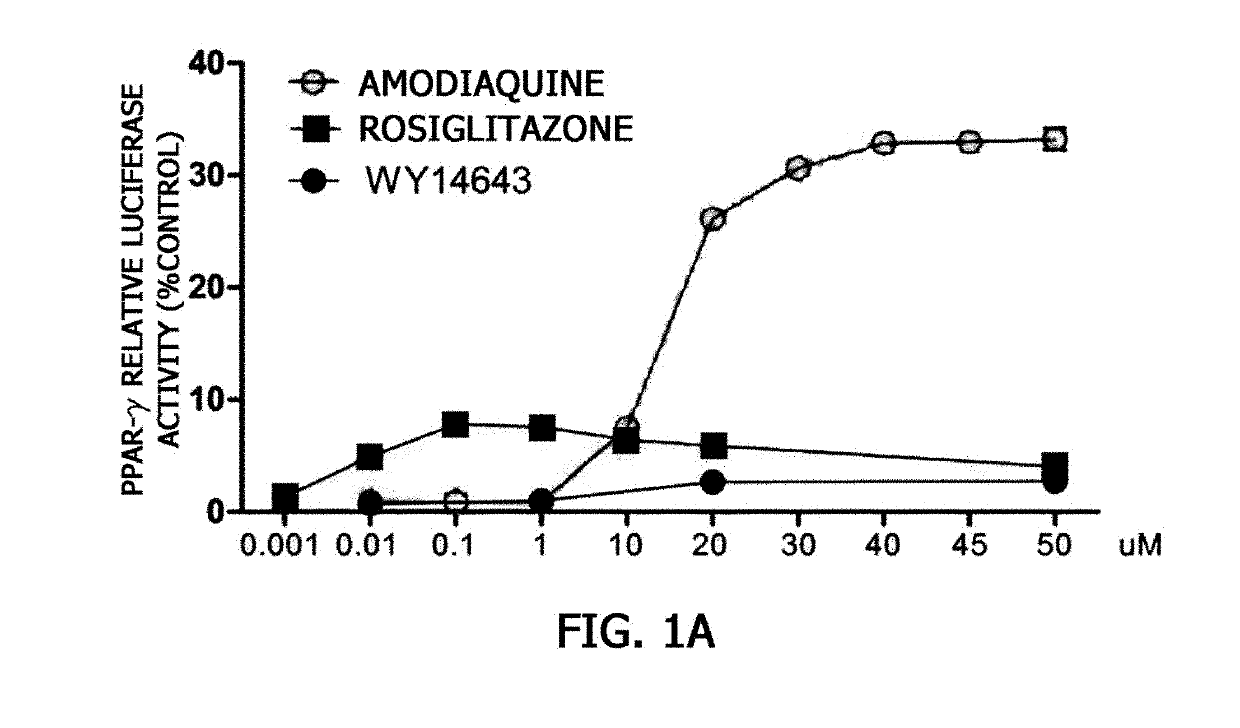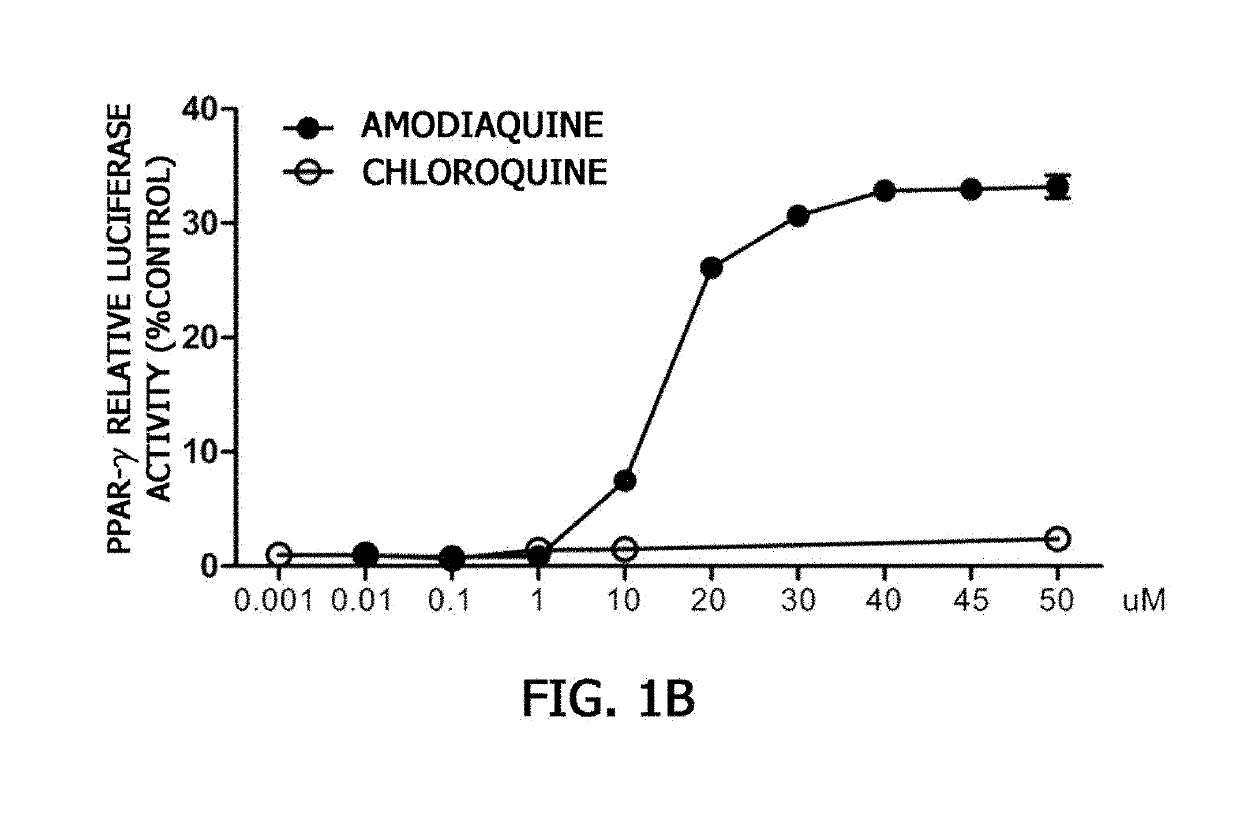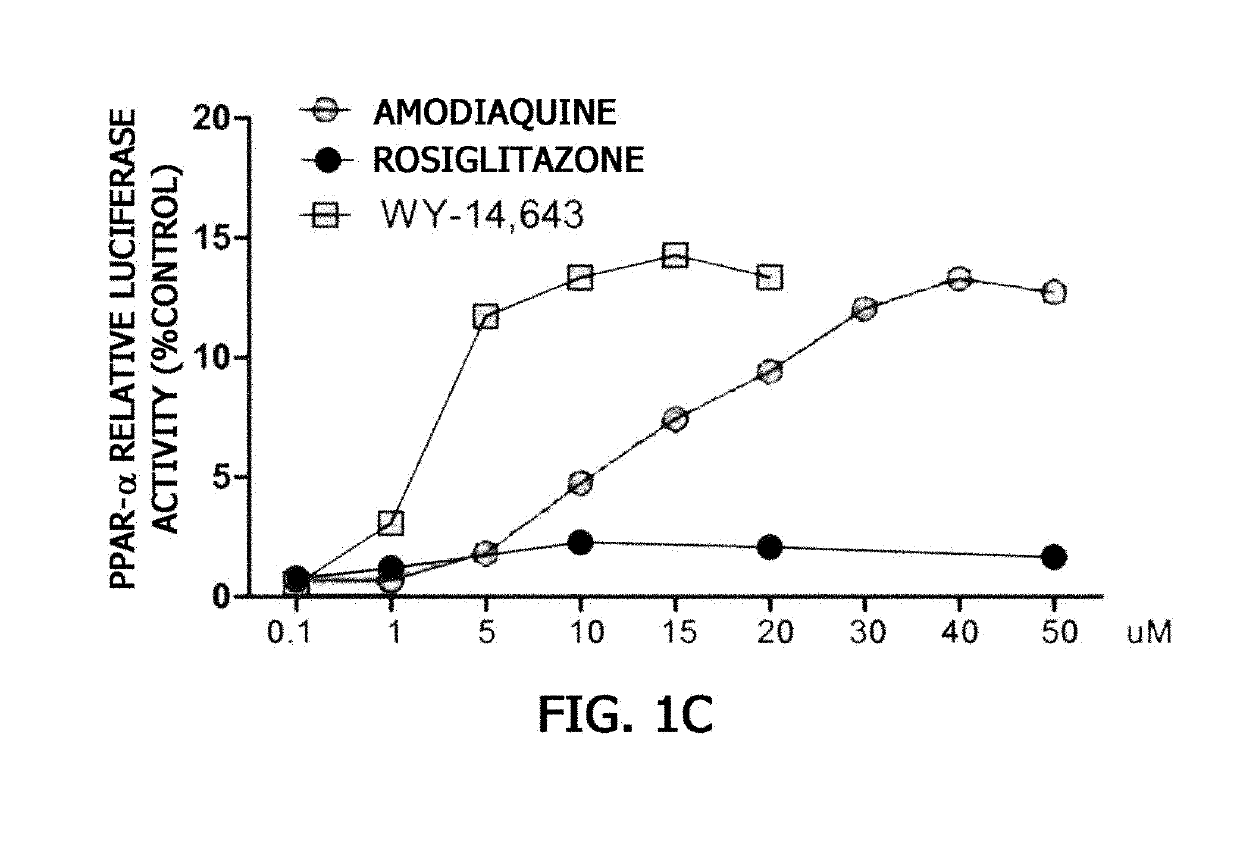Pharmaceutical composition comprising amodiaquine and Anti-diabetes drug as effective ingredient for prevention or treatment of diabetes
a technology of amodiaquine and antidiabetes, which is applied in the direction of drug compositions, peptide/protein ingredients, metabolic disorders, etc., can solve the problems of many side effects of oral hypoglycemic drugs, obesity, dyslipidemia, etc., to promote the activity of ppar- and ppar-, inhibit side effects, and great synergistic
- Summary
- Abstract
- Description
- Claims
- Application Information
AI Technical Summary
Benefits of technology
Problems solved by technology
Method used
Image
Examples
example 1
nt of PPAR-γ or PPAR-α Activation by Amodiaquine
[0081]To examine whether amodiaquine acts as a ligand of PPAR-γ or PPAR-α, three types of vectors were used. An experiment was carried out according to a known method (Cell, 68: 879-887, 1992) using a vector prepared by binding genes expressing a GAL4-DBD (DNA binding domain), which is a yeast transcription factor, and a human PPAR-γ-ligand binding domain (LBD) or PPAR-α-LBD to a SV40 promoter of a pZeo vector, a vector prepared by binding a gene in which a GAL4 gene-binding base sequence (5′-CTCGGAGGACAGTACTCCG-3′) is repeated 8 times to luciferase, which is a reporter gene, and a vector expressing β-galactosidase as a transfection control.
[0082]The activation of luciferase expression was measured after BE(2)C cells were transformed with a GAL4-PPAR-γ-LBD plasmid or a GAL4-PPAR-α-LBD plasmid, a GAL4-luciferase vector, and a β-galactosidase vector for 6 hours, treated with amodiaquine for 20 hours, and then grown in a 5% CO2 incubator....
example 2
nt of Glucose Uptake Effect of Amodiaquine in C2C12 Myotube Cells
[0086]The phosphorylation of insulin receptors occurs due to signal transduction by insulin in muscle, adipose, liver cells, and the like, and accordingly, when various proteins located downstream are phosphorylated, glucose uptake increases, resulting in reduced blood glucose. Thus, a glucose uptake evaluation experiment was carried out to identify whether amodiaquine is effective for diabetes. C2C12 myoblasts, which are muscle cells, were cultured in DMEM containing 10% bovine serum albumin (BSA). When the cell density reached about 80% to about 90%, the medium was replaced with fresh 2% horse serum-containing DMEM, and cell differentiation of the C2C12 myoblasts into myotubes was induced to completely differentiate the cells, and then an experiment was carried out. The completely differentiated C2C12 myotube cells were treated with a well-mixed mixture of 10 μM or 30 μM amodiaquine, 0.1% dimethyl sulfoxide (DMSO), a...
example 3
nt of Effects of Amodiaquine on Lowering and Regulating Blood Glucose in Mice
[0089]3-1. Administration of Amodiaquine and Negative Control
[0090]5-week-old KKAy purchased from Clea Japan was preliminarily raised for one week and then divided into two groups (5 individuals per group).
[0091]The first group was administered PBS and set as a negative control, and the second group was orally administered amodiaquine at a concentration of 18 mg / kg daily for 6 weeks.
[0092]3-2. Measurement of Fasting Blood Glucose-Lowering Effect and Blood Glucose-Regulating Effect in Mice
[0093]For 6-week-long measurement of fasting blood glucose, whole blood was collected from the caudal vein on weeks 1, 2, 5, and 6 after 12-hour fasting. A blood glucose strip (Green Cross, Gyeonggi-do, Korea) was used to measure blood glucose. For the experimental results, significance of the experimental group and the control was verified using a t-test, and the groups showed statistically significant differences (*p<0.05...
PUM
| Property | Measurement | Unit |
|---|---|---|
| weight ratio | aaaaa | aaaaa |
| concentration | aaaaa | aaaaa |
| concentration | aaaaa | aaaaa |
Abstract
Description
Claims
Application Information
 Login to View More
Login to View More - R&D
- Intellectual Property
- Life Sciences
- Materials
- Tech Scout
- Unparalleled Data Quality
- Higher Quality Content
- 60% Fewer Hallucinations
Browse by: Latest US Patents, China's latest patents, Technical Efficacy Thesaurus, Application Domain, Technology Topic, Popular Technical Reports.
© 2025 PatSnap. All rights reserved.Legal|Privacy policy|Modern Slavery Act Transparency Statement|Sitemap|About US| Contact US: help@patsnap.com



